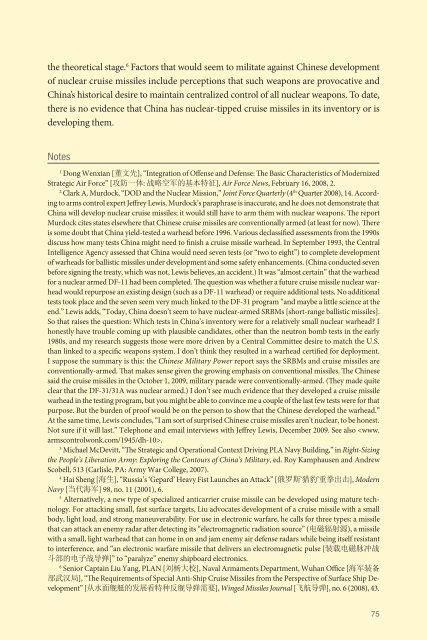Create successful ePaper yourself
Turn your PDF publications into a flip-book with our unique Google optimized e-Paper software.
the theoretical stage. 6 Factors that would seem to militate against Chinese development<br />
of nuclear cruise missiles include perceptions that such weapons are provocative and<br />
China’s historical desire to maintain centralized control of all nuclear weapons. To date,<br />
there is no evidence that China has nuclear-tipped cruise missiles in its inventory or is<br />
developing them.<br />
Notes<br />
1<br />
Dong Wenxian [ 董 文 先 ], “Integration of Offense and Defense: The Basic Characteristics of Modernized<br />
Strategic Air Force” [ 攻 防 一 体 : 战 略 空 军 的 基 本 特 征 ], Air Force News, February 16, 2008, 2.<br />
2<br />
Clark A. Murdock, “DOD and the Nuclear Mission,” Joint Force Quarterly (4 th Quarter 2008), 14. According<br />
to arms control expert Jeffrey Lewis, Murdock’s paraphrase is inaccurate, and he does not demonstrate that<br />
China will develop nuclear cruise missiles; it would still have to arm them with nuclear weapons. The report<br />
Murdock cites states elsewhere that Chinese cruise missiles are conventionally armed (at least for now). There<br />
is some doubt that China yield-tested a warhead before 1996. Various declassified assessments from the 1990s<br />
discuss how many tests China might need to finish a cruise missile warhead. In September 1993, the Central<br />
Intelligence Agency assessed that China would need seven tests (or “two to eight”) to complete development<br />
of warheads for ballistic missiles under development and some safety enhancements. (China conducted seven<br />
before signing the treaty, which was not, Lewis believes, an accident.) It was “almost certain” that the warhead<br />
for a nuclear armed DF-11 had been completed. The question was whether a future cruise missile nuclear warhead<br />
would repurpose an existing design (such as a DF-11 warhead) or require additional tests. No additional<br />
tests took place and the seven seem very much linked to the DF-31 program “and maybe a little science at the<br />
end.” Lewis adds, “Today, China doesn’t seem to have nuclear-armed SRBMs [short-range ballistic missiles].<br />
So that raises the question: Which tests in China’s inventory were for a relatively small nuclear warhead? I<br />
honestly have trouble coming up with plausible candidates, other than the neutron bomb tests in the early<br />
1980s, and my research suggests those were more driven by a Central Committee desire to match the U.S.<br />
than linked to a specific weapons system. I don’t think they resulted in a warhead certified for deployment.<br />
I suppose the summary is this: the Chinese Military Power report says the SRBMs and cruise missiles are<br />
conventionally-armed. That makes sense given the growing emphasis on conventional missiles. The Chinese<br />
said the cruise missiles in the October 1, 2009, military parade were conventionally-armed. (They made quite<br />
clear that the DF-31/31A was nuclear armed.) I don’t see much evidence that they developed a cruise missile<br />
warhead in the testing program, but you might be able to convince me a couple of the last few tests were for that<br />
purpose. But the burden of proof would be on the person to show that the Chinese developed the warhead.”<br />
At the same time, Lewis concludes, “I am sort of surprised Chinese cruise missiles aren’t nuclear, to be honest.<br />
Not sure if it will last.” Telephone and email interviews with Jeffrey Lewis, December 2009. See also .<br />
3<br />
Michael McDevitt, “The Strategic and Operational Context Driving PLA Navy Building,” in Right-Sizing<br />
the People’s Liberation Army: Exploring the Contours of China’s Military, ed. Roy Kamphausen and Andrew<br />
Scobell, 513 (Carlisle, PA: Army War College, 2007).<br />
4<br />
Hai Sheng [ 海 生 ], “Russia’s ‘Gepard’ Heavy Fist Launches an Attack” [ 俄 罗 斯 ’ 猎 豹 ’ 重 拳 出 击 ], Modern<br />
Navy [ 当 代 海 军 ] 98, no. 11 (2001), 6.<br />
5<br />
Alternatively, a new type of specialized anticarrier cruise missile can be developed using mature technology.<br />
For attacking small, fast surface targets, Liu advocates development of a cruise missile with a small<br />
body, light load, and strong maneuverability. For use in electronic warfare, he calls for three types: a missile<br />
that can attack an enemy radar after detecting its “electromagnetic radiation source” ( 电 磁 辐 射 源 ), a missile<br />
with a small, light warhead that can home in on and jam enemy air defense radars while being itself resistant<br />
to interference, and “an electronic warfare missile that delivers an electromagnetic pulse [ 装 载 电 磁 脉 冲 战<br />
斗 部 的 电 子 战 导 弹 ]” to “paralyze” enemy shipboard electronics.<br />
6<br />
Senior Captain Liu Yang, PLAN [ 刘 杨 大 校 ], Naval Armaments Department, Wuhan Office [ 海 军 装 备<br />
部 武 汉 局 ], “The Requirements of Special Anti-Ship Cruise Missiles from the Perspective of Surface Ship Development”<br />
[ 从 水 面 舰 艇 的 发 展 看 特 种 反 舰 导 弹 需 要 ], Winged Missiles Journal [ 飞 航 导 弹 ], no. 6 (2008), 43.<br />
75


